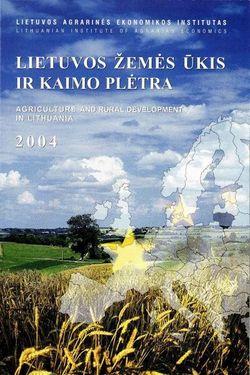
The year 2004 is connected with the historical moment. On 1 May 2004 Lithuania became a member of the EU. The agri-food sector has begun a period of new possibilities and challenges. Free movement of capital, labour and commodities essentially has changed conditions for the development of agriculture and the countryside. The EU single market at once expanded possibilities for the exports and increased competition and requirements on quality and safety of products. On the other hand, the better direct payments, compensations and investment support allowed to restructure and modernise farms and enterprises, to increase farmers’ income, to improve social situation in the countryside.
The national legislation of the Republic of Lithuania in fundamental matters is based on a common European legal foundation. The Rural Development Plan 2004-2006, Single Programming Document 2004-2006, Rural Support Programme as well as legislation regulating EU and national support were adopted. Eligible beneficiaries were informed at special workshops. The enhanced integrated administrative and control system guarantees administration of EU support.
In 2004 rural population made up 33% of the total population, more than 15% of the total number of employees were engaged in agricultural activities. 76.5 thousands of family farms, 630 agricultural companies and other agricultural enterprises were recorded in the Register. The average size of the family farm was 8.1 ha and that of the company amounted to 830 ha.
Gross agricultural output totalled to 4.6 bill. Lt in 2004; over the year it increased by 2%: the output of livestock and poultry grew up by 8%, but that of crops declined by 2%. The amounts of grains, milk, livestock and poultry purchased were larger by 25%, 12% and 7%, respectively. In 2004 compared to 2003 the average purchase price of cattle was higher by 33%, that of pigs by 8%, poultry by 9%, milk by 9% due to integration into the EU single market and due to the measures increasing competitiveness of products.
34 livestock and poultry slaughterhouses, 38 meat, 32 milk, 26 fish processing enterprises are approved for EU intracommunity trade. 22 enterprises introduced ISO 9001 quality management system and 6 enterprises environmental management system ISO 14000. 127 dairy farms have guarantee of production quality. Such EU market regulation measures as intervention purchase and export subsidies were started to implement.
In 2004 compared to 2003 the exports of agricultural and food products grew up by 24.3%, and the imports by 23.4%. A negative trade balance declined to 11 mill. Lt. The EU countries were the major Lithuania’s foreign trade partners. SAPARD funds were important to the Lithuanian agricultural and food sector. 883 agreements for support were concluded accounting for 616 mill. Lt. In 2004 the single payment scheme was started at 55% of the EU level. In 2004 declared crop area covered 2551.9 thou. ha for which eas estimated 0.5 bill. Lt to 238,5 thou. applicants. Due to better support, higher purchase prices of agricultural products and larger amounts farmers’ income increased by 2.9 bill. Lt or by 45%. In 2004 income per employee engaged in agricultural activity made up 12 thou. Lt (in 2003 - 8 thou. Lt).
In 2004 movement of rural communities was more intensive; at the end of the year there were 800 rural communities, of which 320 belongs to the Lithuanian Rural Communities Union. More than 30 local activity groups are established which aim is to participate in the Leader initiative and other programmes and to solve local problems.
Economic and social situation in rural areas, meantime, is complicated; there are many small uncompetitive farms, underdeveloped cooperation, high unemployment rate unfair income, deep regional differentiation.
© Quoting requires reference to the source and website address.
